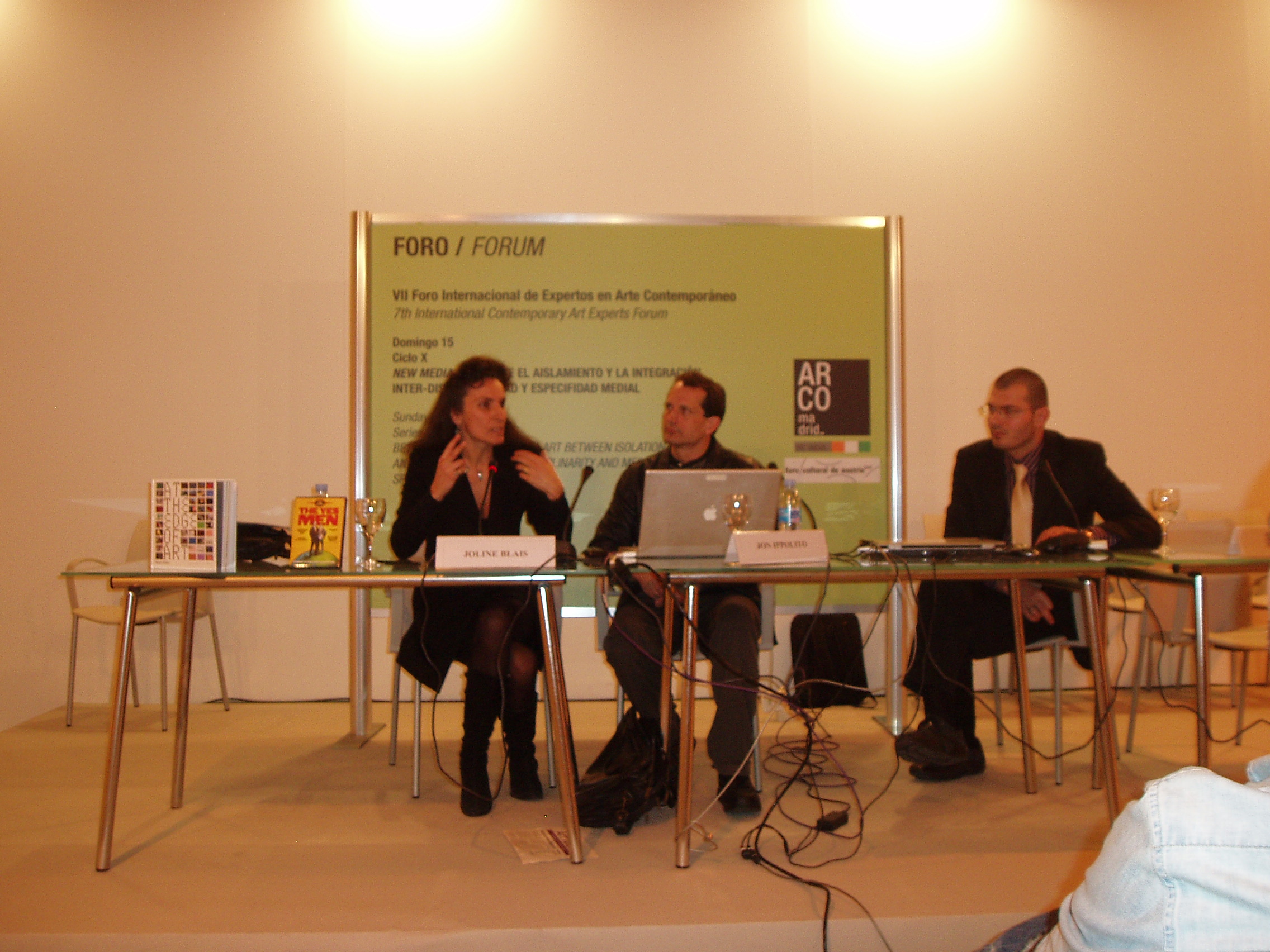Between Fields, New Media Art Between Isolation and Integration, Inter-disciplinarity and Media Specificity Contemporary Arts Experts Forum, ARCO, Madrid, Sunday February 16, 2009 (chair: Domenico Quaranta)
I was the third in this series of talks, each during an hour, one after the other. After me Inke Arns, Regine Debatty, Zhang Ga and Joasia Krysa spoke. Unfortunately, I blogged the first two presentations, then I had to leave. In my presentation I spoke about possible ways out of the ‘crisis of new media arts’, which I addressed at length in the Zero Comments chapter The Cool Obscure.

Joline Blais and Jon Ippolito are US-American curators-artists, teaching in Maine (USA), and authors of the book “At the Edge of Art.” According to Joline and Jon, we have to make a distinction between autonomy and isolation. The flower that grow there are wild. It is a problem for the White Cube, then for new media art. The NY Metropolitan Museum has 2,5 visits per artwork, compared to Rhizome with 700 visits per artwork. Look at the numbers of people that read blogs. How can we leave both ghettos behind? Why not sell artwork through Amazon? But you might ask: is the Internet audience really the one you want? Why are we shy to confront larger audiences? It is in fact the gallery system that is isolated. Blais and Ippolito call to go out of the Duchampian hothouse, which is a constrained space, controlled by gatekeepers. Think of the 1990s work of Art+Com and how it relates, or could relate, to our current Google Earth use. Or the link between Karl Sims’ artificial life forms and today’s screen savers. Or the road from Antonio Muntadas’ The File Room to wikileaks.org.
What we need to do is to go beyond representation. Artworks can simulate and execute, it is not a dead symbolic image. What works on the edge do is create an autopoeisis. They create actual change. We need to envision new strategies in order to tackle the issues of our unsustainable economies and ecologies. It is not just the new media arts world that is addressed by The Yes Men “pranksters.” The same could be said about the Darko Maver artist that the Mattes couple invited. Or the EKMRZ triology by ubermorgen.com, which is a good example of what could be called ‘executed economies’. The recipe is: decolonize. They concluded their presentation with the question: “Why can’t all art be like this?” Turn away from the arts, turn away to each other. The Internet is the ideal tool to do this.
Roberta Bosco from Bacelona/Italy reminded us about the history of net art. In a narrow sense net.art may have been over in 2000, but these days it is bigger than ever. The radical net.art of the 1990s was negative and had no intellectual agenda. New media art is no longer new. Ars Electronica started in 1979. Most ordinary people all have a relationship with technology. We have to leave behind the net.art position. The debate has been dragging on for years and it’s time to leave it behind us. Just look at the Antagonism exhibition at MACBA (Barcelona) and its net.art section. Institutions should have the space, expertise and equipment to deal with these new artistic expressions. Art should address new audiences and cannot afford to ignore contemporary art expressions. Looking at ARCO the situation isn’t all that dramatic. There are new media works sold here and there. Artists should not lock themselves up. Or look at Electroboutique.
There is less video these days at the fair. Video is at the point of disappearing in the background. A number of years ago video was all over. Collecting is becoming be more like creating an archive. But in Spain contemporary art spaces do not collect. What we need is conservation. We do not need large museums but we need to do something to frame and preserve works. Der Fazit: “Are we all ready for Audience 2.0?” Someone from the audience asks: why should this art fit into a museum? And even when new media art works are exhibited, the artists do not get a fee. New media should look for a haven somewhere else. Bosco answers that museums are public. They are run with tax payer’s money. It’s a struggle, yes. But that’s life. Look at children. They can’t imagine a life without computers, games and mobiles.


